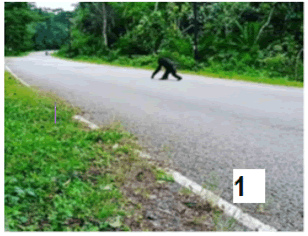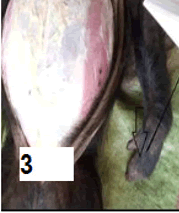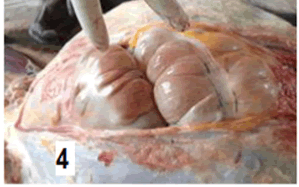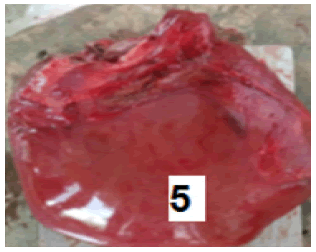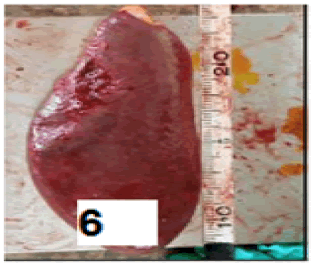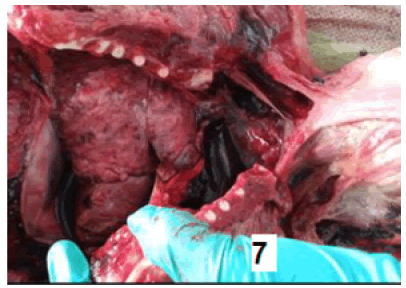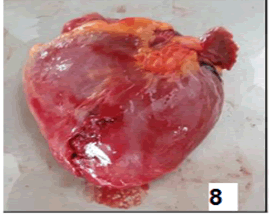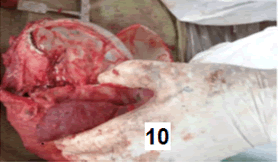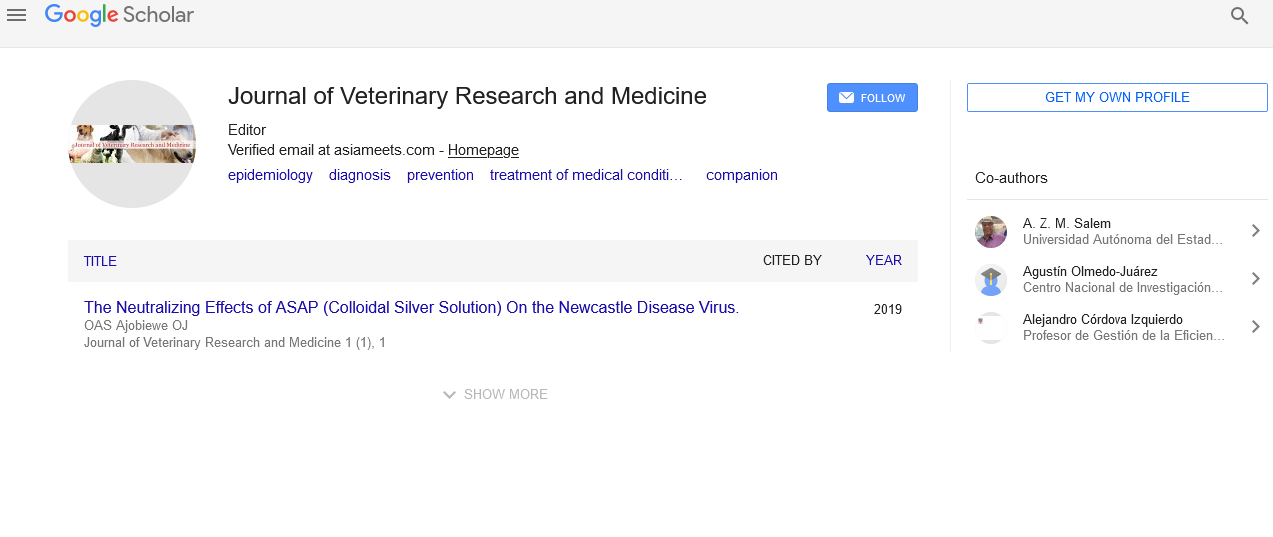Macroscopic post-mortem findings of hit-by-car blunt force trauma of a free ranging chimpanzee in Kibale National Park
Received: 12-Mar-2022, Manuscript No. PULJVRP-22-4478(R); Editor assigned: 13-Mar-2022, Pre QC No. PULJVRP-22-4478(PQ); Accepted Date: Mar 29, 2022; Reviewed: 23-Mar-2022 QC No. PULJVRP-22-4478(Q); Revised: 28-May-2022, Manuscript No. PULJVRP-22-4478; Published: 07-Apr-2022
Citation: Nelson B. Macroscopic post-mortem findings of hit-by-car blunt force trauma of a free ranging chimpanzee in Kibale National Park. J Vet Res Med. 2022;4(2): 01-03.
This open-access article is distributed under the terms of the Creative Commons Attribution Non-Commercial License (CC BY-NC) (http://creativecommons.org/licenses/by-nc/4.0/), which permits reuse, distribution and reproduction of the article, provided that the original work is properly cited and the reuse is restricted to noncommercial purposes. For commercial reuse, contact reprints@pulsus.com
Abstract
Kibale National Park (KNP), Uganda also referred to as primate capital of the world is a home to several primate species including the endangered Eastern Chimpanzees (Pan troglodytes schweinfurthii). Road accidents have been reported globally to cause both direct and indirect negative impact on wildlife such as mortality from car accident collisions and alteration of natural landscape which may have an impact on behavioural patterns of wildlife respectively. This case reports presents post-mortem findings in an oestrous subadult chimpanzee involved in a speeding car accident along Fort Portal-Kampala Road through KNP and was reported dead on spot. Physical examination of the cadaver indicated good overall body condition; at 30 kg, the deceased female was on oestrous one with mild swelling The left and right mammary gland was of normal size with no signs of any lactation recent lactation. The individual was on estrous one by the time of death There was marked cardiac laceration around the right ventricle. The recoil of the skull led to the damage of the brain and hemorrhages. From the above findings, the probable cause of death is attributed to effects from blunt trauma force and collision from the car followed by a cascade of hypovolemic shock from internal hemorrhage (and brain damage) secondary to contralateral brain hemorrhage.
Key Words
Wildlife car accidents; contralateral brain hemorrhage; hypovolemic shock; internal hemorrhage; Blunt force trauma.
Introduction
As new roads penetrate through the last surviving pristine naturally habitats such as Kibale National Park, this comes at the cost of both development and conservation [1]. Globally, chimpanzees (Pan troglodytes schweinfurthii) are classified endangered as per IUCN Red list. Of recent, in addition to other form other forms of human induced mortalities in free ranging wild chimpanzees such as snaring, mantraps and others, the alteration of natural habitats through human induced infrastructural development such as roads, has also resulted into rampant incidences of wildlife collisions and mortalities with vehicles and motorcycles [2-4]. Therefore, these alterations in natural habitats are grossly associated with adverse effects on animal communities and ecosystems such disturbance of animal movement and behavior and thus each vehicle accident should be considered very important [5].
Case History
On the 08/06/2020, a female subadult chimpanzee from the Sebitoli chimpanzee community, one of the four habituated groups in Kibale National Park was reported dead at 6:00pm by the local community because of collision from a speeding to the Uganda wildlife Authority. The incident was reported to have happened along the Fort Portal-Kampala Road through Kibale National Park. The resident veterinarian was contacted, and a postmortem was conducted the following morning on 09/06/2020 .
Post-mortem findings
Following safe necropsy standard operating procedures, the post-mortem was performed in personal protective equipment. The animal was weighed and found to be 30 kg, an ideal weight for sub adult female chimpanzees. On external examination, the female was on the third oestrous with visible swelling of the perineal area and in a good body condition. With examination of the integumentary system, no external parasites were found, however, marks of deep cuts, abrasions and wounds were found on the head, fascial area, and limbs. Additionally, the examination of musculoskeletal system demonstrated missing first, third, fourth and digits which could be attributed to snare injuries or bites during intra and inter-community fights. A visible deep wound was found below the lower lip, with marked fractured right mandibular bone at the second premolar tooth. The head was found with deep penetrating wounds on the right side (Figures 1-3).
Furthermore, the animal was placed in a supine position on a tarpaulin, and all the four limbs were disjointed by incision of the muscular attachments in the axillary and inguinal regions. A ventral midline incision was created from the pubic region up to the mandibular symphysis to expose both the thoracic and mandibular cavities. On examination of the internal abdominal lining and cavity, marked paint brush haemorrhage in the abdominal muscles, marked distended abdominal organs with clotted blood on the base of the abdominal cavity. The stomach and intestines were distended with marked paint brush haemorrhage on the intestines (jejunum and colon) (Figure 4).
There was marked lacerations on the middle and right liver lobes and dented incisions on the spleen (Figures 5 and 6). Both organs may have contributed to the large blood quantities found on the base of the abdominal cavity. The spleen also had multiple small white nodular lesions under its surface.
Additionally, opening the thoracic cavity, the diaphragm was punctured at the base, with a pool of blood (haemothorax) observed at the base of the thoracic cavity (Figure 7). There was marked laceration of lungs with severe intra-pleural or mediastinal hemorrhage. Additionally, visible petechial hemorrhage was noticed in the left lung. The heart was marked with a long right ventricular laceration (Figure 8).
The examination of the head indicated marked laceration of the scalp on the right side, and following incision through the skull, the dura matter was broken due to the pond fracture penetrating through the right side of the skull, with marked extradural haemorrhage and underneath on the brain surface (Figures 9 and 10).
Discussion
All external visible wounds were critically evaluated and aged to rule out any prior injury because of a bite from intra and inter-group fights or from local community such as spear injuries to rule out a possibility of the individual running away from the above into a moving car while crossing the road [6]. Reports have indicated that the severity of blunt trauma injuries is determined by several factors; (1) extent of force exposed to the body, (2) the time range force is projected (3) the body part involved, and (4) the body part surface area in contact with force [7]. Furthermore, the anatomical structure and position of body organs in their respective cavities determines the extend of severity from the blunt force trauma. Therefore, with the application of kinetic energy to abdominal or thoracic walls, the force will be transmitted through the muscular and bony tissues until it reaches the most friable and plastic body organs that are intolerant to mechanical stress such as the liver, heart, spleen, the lungs, and others. Furthermore, the pathological state of an organ may determine the results from exposure to a blunt force, and in this case the necrotic nodular lesions in the spleen could have created a weak integrity of the organ [7].
Blunt trauma injuries can be categorized into primary and secondary, with primary injuries linked to direct contact with the vehicle while secondary injuries linked to contact with the ground. Therefore, for this case, witnesses reported that the thrown forward and on hitting the ground, it suffered secondary injuries [8]. The bruising of the abdominal muscles and the underlying muscles could be linked to secondary hitting of the body and dragging on the rough surface of the road. Furthermore, because the abdominal cavity is not encapsulated into any bony structure, the internal organs (intestines, liver, spleen, and mesentery) are more susceptible to damages. The pool of blood in the abdominal cavity could be linked to rapture and bruising of the of the mesentery because of compression to lumbar spine. Additionally, the spleen and liver laceration could be as a result of impact of blunt force on the surfaces of the two organs from, thus more blood oozed out into the abdominal cavity [7,8]. Furthermore, within the thoracic cavity, irrespective of visible damage to the musculoskeletal system of the chest cavity, there is a possibility of transmission of kinetic energy to the internal organs resulting into damage such as lung rapture which is attributed to their elasticity and delicate capillary network, the heart in this case right ventricle which is susceptible due to the thin muscular walls as compared to the left with thick muscular layers. Therefore, the rapture and laceration of these two organs could have resulted bleeding into the thoracic cavity [7,8]. Additionally, the pond fracture in the skull resulted into extradural and subdural hemorrhage because of rupturing of the meningeal arteries thus accumulation of a hematoma all over the hemi cranium which may also have exacerbated into contralateral brain hemorrhage [8].
Recommendations
Globally, road construction and establishment in primate occupied natural habitats present a major threat and thus a need to advocate for eco-friendly infrastructural development such as establishment of canopy bridges in form of rope bridges where animals cross over [9], careful case-case assessment of road construction projects in their initial stages to seek for other possible alternatives enforcing laws as regard to speed limit in natural habitats, reduction of road width within natural habitats to allow fast cross over by wildlife [10], re-route certain vehicles such as heavy trucks that may impose severe damage to wildlife as compared to passenger vehicles [11] and many other viable solutions can be implemented to preserve nature and wildlife.
Conclusion
As a routine, several tissue and fluid samples are collected for every wildlife causality for disease investigation and future reference in the case of new findings. In this case samples were submitted to the laboratory for further bacteriological and histopathological investigations. In conclusion to the above post-mortem finings, the pathology suggests that the chimpanzee succumbed to death due to hypovolemic shock from internal hemorrhage (and brain damage) secondary to contralateral brain hemorrhage.
REFERENCES
- Laurance, WF, et al. A global strategy for road building. Nature. 2014;291:229-32
Google Scholar - Hyeroba, D. et al. Short Communications regimen for chemical immobilisation of free-ranging chimpanzees. 2013-2015;172(18):475
Google Scholar Cross Ref - McLennan, M. R. et al. Chimpanzees in mantraps: Lethal crop protection and conservation in Uganda. Oryx. 2012;46(4):598-603.
Google Scholar Cross Ref - Mclennan, M. R. and Asiimwe, C. Cars kill chimpanzees : case report of a wild chimpanzee killed on a road at Bulindi , Uganda. Primates.’ 2016;57:377-88
Google Scholar Cross Ref - Parchizadeh, J. et al. ‘Roads threaten Asiatic cheetahs in Iran’. Curr Biol. 2018; 28(19):1141-42.
Google Scholar Cross Ref - Munro, R. and Munro, H. M. C. Some challenges in forensic veterinary pathology: A review. J Comp Pathol. 2013;149(1):57-73.
Google Scholar Cross Ref - Ressel, L., Hetzel, U. and Ricci, E. Blunt Force Trauma in Veterinary Forensic Pathology. Vet Pathol. 2016; 53(5): 941-61.
Google Scholar Cross Ref - Saukko, P. and Knight, B. ‘KNIGHT’S Forensic Pathology’, 2004;291.
Google Scholar Cross Ref - Teixeira, F. Z. et al. ‘Canopy bridges as road overpasses for wildlife in urban fragmented landscapes’, 1940;13(1).
Google Scholar Cross Ref - Rico, A., Kindlmann, P. and Sedláček, F. ‘Barrier effects of roads on movements of small mammals’,2007; 56(1):1-12.
Google Scholar - Zimmerman, K. ‘for Trucks at High-Speed Signalized Intersections’, 2009; 82-88.
Google Scholar Cross Ref




